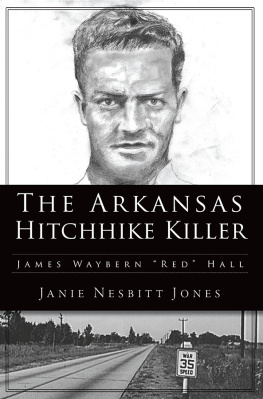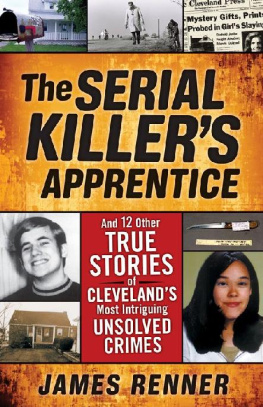

Published by The History Press
Charleston, SC
www.historypress.com
Copyright 2021 by Janie Nesbitt Jones
All rights reserved
First published 2021
e-book edition 2021
ISBN 978.1.43967.220.4
Library of Congress Control Number: 2020948551
Print edition ISBN 978.1.46714.817.7
Notice: The information in this book is true and complete to the best of our knowledge. It is offered without guarantee on the part of the author or The History Press. The author and The History Press disclaim all liability in connection with the use of this book.
All rights reserved. No part of this book may be reproduced or transmitted in any form whatsoever without prior written permission from the publisher except in the case of brief quotations embodied in critical articles and reviews.
CONTENTS
This book is dedicated to my father, Gordon Nesbitt, the dream-weaver, and to my husband, Wyatt Jones, who made my dreams come true.
AUTHORS NOTE
This book is about the life and crimes of serial killer James Waybern Red Hall. It is based on newspaper and magazine articles, court documents, and interviews with people who interacted with Hall personally. Though many of the conversations and events in the narrative are my dramatic interpretations of what was said and done, I have tried to be as faithful to the truth as possible. I have quoted much of the dialogue verbatim from accounts by the primary reporter on the case and from testimonies of witnesses as recorded in the trial transcript. Recollections of those who knew him were invaluable to me as I tried to acquire a sense of who this man was and why he committed such dreadful deeds. Some names have been changed by request.
ACKNOWLEDGEMENTS
For their contributions in making this book possible, I offer my sincerest gratitude to the following people:
Jim Chandler, historian of the 455 th Anti-Aircraft Artillery Battalion (World War II); Kevin Ellis, managing editor of the aston Gazette; Bill Cook, cousin of Corporal Charles W. Nipper III; the staff at the Faulkner County Library; Alicia Jones with UCAs Torreyson Library; Melinda Herder, director of the Humboldt Public Library; Claudia Beck with the Seminole Public Library; Adele Heagney with the St. Louis Public Library; and Kathryn Fitzhugh from the UALR William H. Bowen School of Law.
I also want to thank Vicki Vowell, founder of AY Magazine, who helped me find my calling in true crime; Rhonda Love for her wise counseling and for believing in me when I didnt believe in myself; Dr. Jeffrey Marotte, who played a vital role in the completion of this narrative by saving my life, literally; Dr. Tyrone Lee, who saved my life a second time; Chad Rhoad, senior acquisitions editor at Arcadia Publishing, for his patience and guidance; The History Press production editor Abigail Fleming, with her keen eye for detail; and all the staff at Arcadia Publishing for their roles in producing the book.
I thank all my friends and family members for exhibiting saintly patience and good humor while I talked obsessively about the subject of this chronicle. In conclusion, I couldnt have fulfilled my desire to finish the story of Red Hall without my dear and talented husband, Wyatt Jones, who always has my back.
EL DIABLO
There is a community in Faulkner County, Arkansas, called Happy Valley, where springtime comes dressed in yellow flowers, and summers stifling heat is tempered by the ice creamy smoothness of Julys blue skies. In autumn, the wooded hills around the vale adorn Mother Natures breast with garnet, coral and amber brooches. Winter covers everything with a swansdown blanket. This seemingly idyllic setting is a seductive sham, for it once produced a man whose heart was as dark as night.
Happy Valley lies between Hardin Hill and Whitmore Mountain to the south and east and Bailey and White Oak Mountains to the west and north, respectively. Actually, mountain is a misnomer, because the highest peak, White Oak, at only 639 feet, falls far short of the 2,000-foot height requirement to qualify as a mountain, but it passes as such in a state where the highest point of land is Mount Magazine (2,753 feet), located near the little town of Paris in Logan County.
At the time this story took place, Happy Valley comprised a few farms loosely connected to nearby neighborhoods that included McGintytown, Marcus Hill and Barney. The social hub was the town of Enola, where the post office was located. Pioneers who settled in the area found the land to be fertile and productive, and it still seems to be an uncommonly favorable environment for health and longevity. It could be wagered that more nonagenarians reside in Enola and surrounding communities than anywhere else in Arkansas. Many residents have lived to see the century mark and beyond.

Happy Valley, where it all began. Photo by Wyatt Jones.
Among the early arrivals in Happy Valley were the Hall and Ingram families. The Ingrams bought farmland in 1859 and built a dogtrot log house about one hundred feet from the old Little RockClinton Road. In the dogtrot style of architecture, two cabins were connected by a roofed passageway where saddles, tack, farm implements and household articles hung from pegs on the walls, but the primary purpose of the breezeway was to provide more comfortable sleeping arrangements during the hot, humid summers.
The Hall family moved to the area in 1906 and built their home also just off the old Little RockClinton Road near the Ingrams. The house had a wraparound porch, and the yard was immaculately kept. Daffodils, narcissus and irises bordered the walkway that led from the front gate to the house. To the left of the gate was a flowering quince tree, and to the right was a large persimmon tree that bore fragrant white blossoms in late spring and sweet fruit in the fall. Raccoons had a field day with the delicacy.
Two members of the Hall and Ingram families became more than neighbors on September 14, 1913, when Eva Lorena Ingram married Samuel Jerome Hall. They had ten offspring, five boys and five girls. Another child died in infancy. Samuel was a farmer and a preacher in the Primitive Baptist Church. Religion was an important function for the family and their kin. A lot of baptisms took place in Cadron Creek about a mile south of Happy Valley. Sometimes on Sundays after a worship service of preaching, prayers and a cappella singing, young people would gather at the Cadron Bridge and socialize.
Eva and Samuels fourth-born was James Waybern, though he was better known by his nickname, Red. He had wavy red hair that was the envy of many a little girl. One day when he was visiting his cousins, he led them and his three older siblings into the woods and found a sizable tree stump, which he turned into a pulpit. Imitating his fathers oratorical style, he proceeded to give a spirited sermon. He was really going good, a cousin said, Until one in the group stepped on a hornets nest. The sermon stopped abruptly after the little girl was stung on her arms and neck and had to be carried up to the house where Reds grandmother eased the painful stings with a poultice made of dipping snuff, right out of the dippers mouth, an effective remedy for wasp, bee and hornet stings. The abbreviated biblical lecture was the last time Red commanded a congregation, for in a few years, people who knew him would say he was never what you would call sitting in the front pew of the church.
Next page















